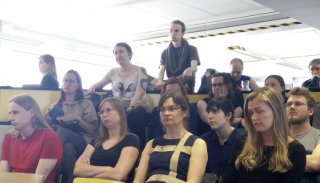
The Helsinki Institute for Information Technology (HIIT) arranged a film evening in the premises of the software company Futurice in May. HIIT showed the American documentary film ‘Code Debugging the Gender Gap’, which focuses on programming, gender and minorities.
- Gender is a highly charged subject. Cultural differences were the most important issue highlighted in the panel discussion following the screening. This is because the film mainly examines the subject from the American perspective. However, the matter is not so clear-cut in Finland either and we too must pay attention to how woman employees are treated, says Matti Nelimarkka from HIIT, explaining the background to the event.
There are already gender gaps during basic education. Studies show that the feeling of computer incompetence is more common among girls than among boys. Boys do not feel so strongly about the matter even if their skills were at the same level.
- I took part in a mathematics competition in which one girl and me were among the finalists. Among the top finalists, the ratio between girls and boys was one to nine, explains 14-year-old Victor Branea, who is doing his work practice at HIIT.
According to the documentary film, the amount of IT work and the demand for programmers is increasing every year and it is impossible to meet the growing need without also recruiting women to the tasks. The importance of role models was underlined in the film and during the panel discussion. Women are needed as role models so that more girls would be willing to work in the IT sector.
- Women are often considered as strangers who are unable to master such tasks as programming and they must often work hard in order to show that they are real professionals, explains Marjo Kauppinen, the only woman professor at the Department of Computer Science, Aalto University.
The panelists also expressed the view that people writing the job advertisements for the IT sector should ensure that the advertisements appeal to women.
- A recruitment advertisement often contains a technology-oriented list of the technology skills required for the job. Women have a different perspective and they give priority to the benefits achieved through technology. If the job advertisements were more than just lists of technological skills, there would be more applicants, both women and men, who are interested in changing the world with the help of technology, adds Kauppinen.
Studies show that men are by nature able to pick the human content from information technology whereas for women information technology is first and foremost a matter of technology.
Reference: Papastergiou, M. (2008). Are Computer Science and Information Technology still masculine fields? High school students’ perceptions and career choices. Computers & Education, 51(2), 594–608. http://doi.org/10.1016/j.compedu.2007.06.009
Contact person: Matti Nelimarkka
Last updated on 22 Jun 2016 by Noora Suominen de Rios - Page created on 22 Jun 2016 by Noora Suominen de Rios